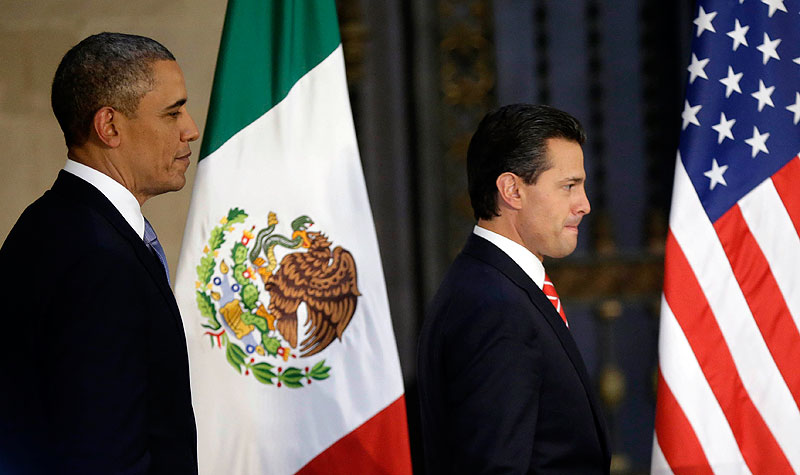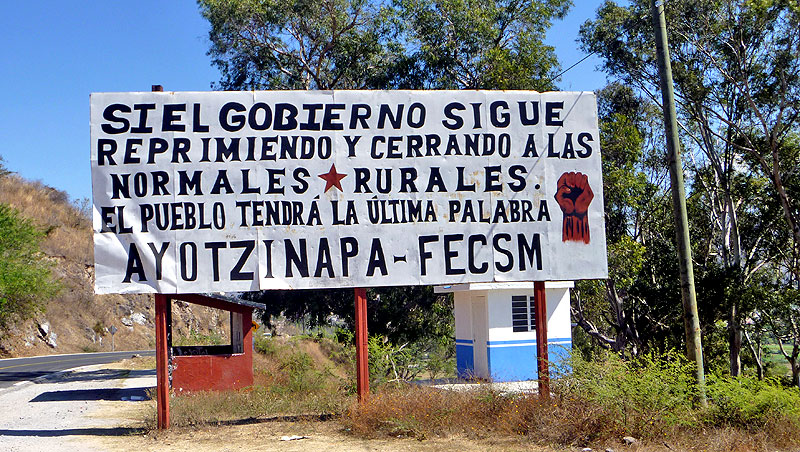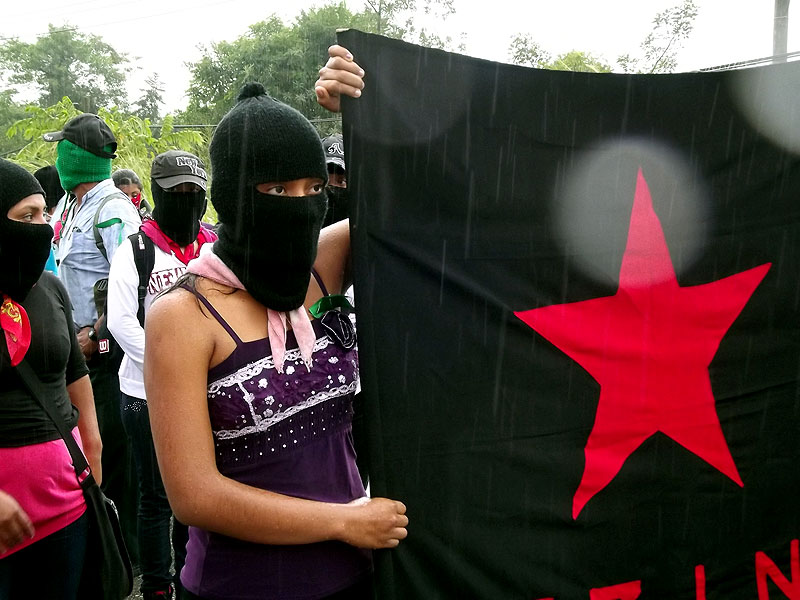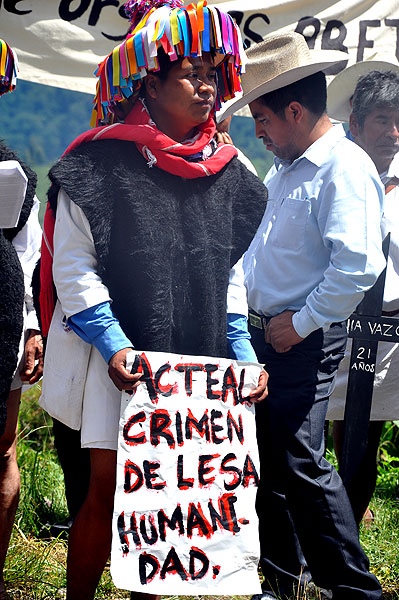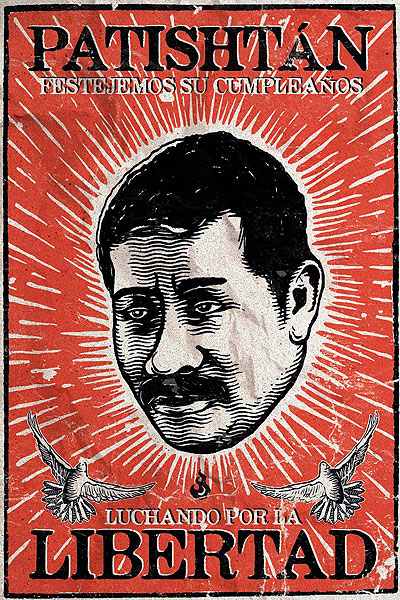SIPAZ ACTIVITIES (From mid-November 2012 to mid-February 2013)
24/02/2013
IN FOCUS : The unsustainability of the Extractive Mining Model
27/05/2013At the beginning of May, President Enrique Peña Nieto met for the first time as president with Barack Obama, president of the U.S.A. In this first meeting of the two leaders, they discussed several bilateral issues and proposed mechanisms of collaboration in economic and educational affairs, a move that was subsequently interpreted as an attempt to “denarcotize” the agenda.
In general, while the federal government announced that there would be changes in the security strategy and that the number of soldiers involved in police work had decreased, still the Army is deployed on the streets. In terms of the struggle against organized crime, there was debate regarding the murders that have occurred under Peña Nieto’s watch. The Secretary of Governance stressed that there has been a decrease in homicides in comparison with the previous government, yet this claim has been challenged in the media and by civil organizations. At the close of April, according to official statistics, 5,296 murders were recorded, presumably linked to organized crime, since the beginning of the new administration.
Also at the beginning of May, Christof Heyns, UN Special Rapporteur on extrajudicial executions, ended his visit to Mexico. Upon ending his stay, Heyns pointed to the lack of an effective application of existing laws as the principal source of the impunity and the public’s distrust of the authorities. Heyns emphasized that past cases must be resolved so that the cycle of violence can be broken. He also pronounced himself on the creation of the National Gendarmerie, a federal government project, warning that very little is currently known about this initiative, and that a special law should be created to regulate its operations, under civilian direction and with mechanisms for accountability.
The Mexican State, which in October of this year will be evaluated in terms of human rights by the Universal Periodic Review (UPR) of the United Nations, will also have to appear this year before the Inter-American Commission on Human Rights (IACHR), due to several cases that have occurred during previous administrations. One of these is the more than 20 women who were tortured and raped during the operations undertaken by federal, state, and municipal police in May 2006 in San Salvador Atenco, Mexico state. A handful of police were charged with minor crimes, however their superiors have not been held accountable, although the Supreme Court for Justice in the Nation (SCJN) has recognized the crimes committed by authorities at different levels. A particularly interesting component of the case is that the current president was at the time of this operation governor of the state of Mexico.
The dangers that journalists face in Mexico continue to be substantial. Statistics presented at the end of April reveal that from 2000 to date, 84 journalists have been killed. In only 12 cases were sentences handed down against the aggressors. Furthermore, from 2005 to the end of April 2013, 20 disappearances of journalists and 39 attacks on media offices have been recorded. Another type of work that in recent years has been targeted by harassment and assault is that of human rights defenders in general, given the explosion of cases against defenders of migrants. In March, Rubén Figueroa and Fray Tomás González, collaborator and director, respectively, of the Migrant Refuge Home “La 72,” were threatened with death in Tenosique, Tabasco.
Structural reforms adopted by Peña Nieto and opposition to the reforms
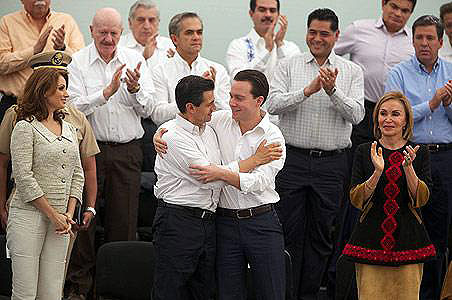
© Office of the President
Enrique Peña Nieto’s government has advanced certain points of its political agenda, and these have been challenged by parts of society, even leading to protests. Among these is the question of the “Pact for Mexico” signed by the three major political parties — Institutional Revolutionary Party (PRI), National Action Party (PAN), and the Party of Democratic Revolution (PRD), which have all supported labor and educational reforms. Financial and energy reforms are still to come.
The “National Crusade against Hunger,” an initiative launched in January by the Peña Nieto government in the Chiapas state municipality of Las Margaritas, once again brought together a part of the federal cabinet with Chiapas state officials in Navenchauc, Zinacantán municipality, in April. In his comments, Enrique Peña Nieto asked Rosario Robles Berlanga, Secretary of Social Development, to “weather” the criticisms of those who “worry about elections.” The previous day, Robles Berlanga fired the delegate of this agency in Veracruz so that he could be investigated for his presumed embezzlement of Crusade resources to assist the PRI in the forthcoming elections in that state. These acts resulted in a temporary suspension of the Pact for Mexico. But after agreeing to mechanisms that would inhibit the use of governmental programs for electoral ends, the three parties that comprise the Pact once again launched it publicly in May.
Educational reform, challenged by analysts as a step toward the privatization of public education and considered a “labor reform for teachers,” among other things mandates the periodic evaluation of teachers. A few days before the vote on this proposal, Elba Esther Gordillo, former leader of the National Union of Educational Workers (SNTE), was arrested; she was known in previous administrations for her power to negotiate with the federal government even beyond educational affairs. Accused of diversion of funds and criminal association, she now finds herself incarcerated while her case is being processed.
Meanwhile, certain dissident sections of teachers and the new national administration of the trade union have mobilized against the proposed reforms. Teachers from Guerrero, joined together in the State Coordination of Educational Workers of Guerrero (CETEG), have on several occasions blocked the Sol highway which connects Acapulco with Mexico City. They have also carried out marches and protests in which various sectors of the local populace have participated, including the Communal Police, and this has led to the founding of the Guerrero Popular Movement (MPG). The state government several times has held dialogues with the CETEG, toward the end of a possible inclusion of its proposals within the state law on educational reform. However, the state government has not been able to suppress the protests, and on some occasions the federal government has even bypassed the state government, seeking to negotiate directly with CETEG so as to stop its periodic highway blockades.
Guerrero: between teachers’ mobilizations and chronic problems
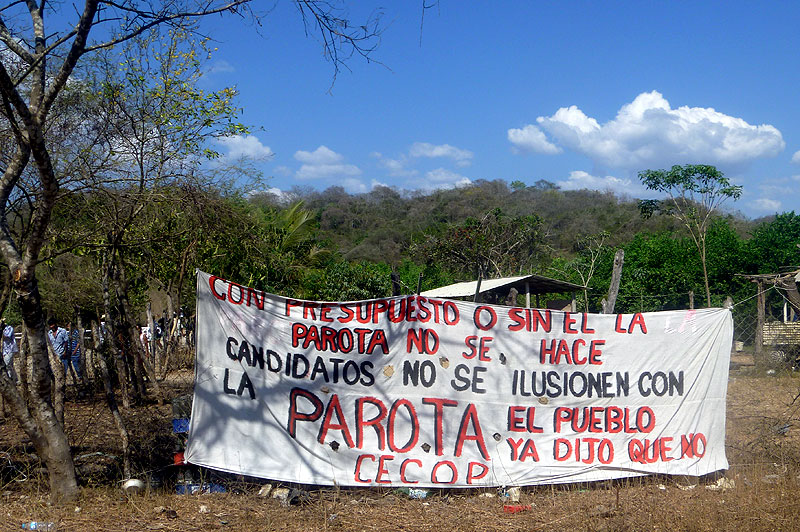
© SIPAZ
While the most sensitive question with the greatest amount of media coverage has been the mobilization undertaken by teachers and other social sectors in recent weeks, other tendencies that reflect chronic problems in the state have continued unchecked. In May, Humberto Salgado, Secretary of Governance, resigned his post due to the crisis that the state government confronts over the deepening of social conflict, including the teachers’ movement and the proliferation of citizens’ self-defense groups.
In April, the two police officers were released who had been arrested for the December 2011 murder of two students during the violent operation undertaken by the federal, state, and municipal police to repress a peaceful student march in Chilpancingo. The Tlachinollan Mountain Center for Human Rights, which is representing the case, has noted that this release demonstrates the high degree of impunity that exists in Guerrero. Also, new death threats have been directed against Obtilia Eugenio Manuel, president of the Organization of the Me’phaa Indigenous People (OPIM), which is based in Ayutla de los Libres. She and all other members of the OPIM enjoy protective measures, awarded by the Inter-American Court on Human Rights (IACHR) in 2009.
In other news, in February, in the community of Los Huajes, the home of the son of Julián Blanco, a leader of the opposition to the La Parota dam, was ransacked by soldiers. For this reason, the Council of Ejidos and Communities Opposed to the La Parota Dam (CECOP) has declared itself on red alert, warning that if the Army maintained its presence in the area, CECOP would reactivate the checkpoints that had been installed at the beginning of the movement. CECOP stressed that the federal government has budgeted 500 million pesos for restarting the La Parota project, noting that it is not a coincidence that there is a high number of abuses committed by soldiers in the area, given that there are private interests pushing to have the dam built. The organization announced that campesinos will continue struggling until the construction project is canceled definitively.
Oaxaca: Mobilization of teachers and conflicts over megaprojects
In parallel to the Guerrero CETEG, teachers from Section 22 of the National Union of Educational Workers (SNTE) have also mobilized. In April, following the removal of teachers in the state of Guerrero after their blockade of the Sol highway, 200 federal police arrived in Oaxaca to prevent radical protest actions that the Section 22 teachers might undertake. At the beginning of May, following their evaluation of official responses to their demands as being inadequate, the trade union decided to transfer 30% of its members to Mexico City, with the goal of “strengthening the struggle in the national arena.”
On 1 May, a commemorative march for International Workers’ Day was held in Oaxaca City which saw confrontations between protestors and municipal police. 34 persons were arrested. The Committee for the Comprehensive Defense of Human Rights Gobixha (CODIGO-DH) reported that police fired into the air and into the ground a short distance from those protesting. Furthermore, Gobixha has demanded the release of Susana Ramírez Jiménez, member of CODIGO-DH, who was arrested while she was documenting abuses committed by the authorities. She was held incommunicado, prevented from speaking with her lawyer and family until 14 hours into her detention. Moreover, harassment targeting CODIGO-DH occurred both before and after these events: in April, its offices were ransacked, with its coordinator, Alba Cruz Ramos, also receiving death threats. The organization linked these attacks on its work to its accompaniment of community human rights defenders, many of whom themselves face intimidation due to their work.
The major tension in this regard occurred in the Tehuantepec Isthmus, where part of the population has organized itself against the construction of wind-energy parks in the region. The harassment of different community radio stations in the Isthmus is similarly infamous. In May, the Meeting of Peoples in Resistance for the Defense of Territory took place in Juchitán de Zaragoza, where it was agreed that the construction of the Bii Hioxio wind-energy park (owned by the Spanish firm Fenosa Natural Gas) would be prevented using popular protest, and that there would be a boycott of voting in the Isthmus in state elections slated for 7 July.
In May, skepticism greeted the announcement by the Secretary for Tourism and Economic Development from the Oaxaca state government that Mareña Renewables would suspend its construction of the wind-energy park in San Dioniosio, instead moving this project to a different part of the region. Subsequently, it was announced that the occupation of San Dionisio’s City Hall would continue, as would the blockade of the municipal office in Álvaro Obregón and the sit-in at the exit from Juchitán against the construction of the Bii Hioxio wind-energy park, once the respective assemblies analyze the government’s announcements and see these declarations officially made in writing.
With regard to mining, March marked the one-year anniversary of the murder of Bernardo Vásquez Sánchez, spokesperson for the Coordination of Peoples United in Defense of the Ocotlán Valley (CPUVO), who opposed the mining operations undertaken by the Cuzcatlán firm, a subsidiary of Fortuna Silver Mines Inc., located in San José del Progreso. Some 200 people carried out a ceremony in front of the mine. According to the Miguel Agustín Pro Juárez Center for Human Rights, once the ceremony ended, the entire group was arrested when 5 trucks full of people affiliated with the mine blockaded all exit-points and began shooting, to intimidate the group of organizations that was participating in the event.
Chiapas: Peak of conflictivity in several areas of the state
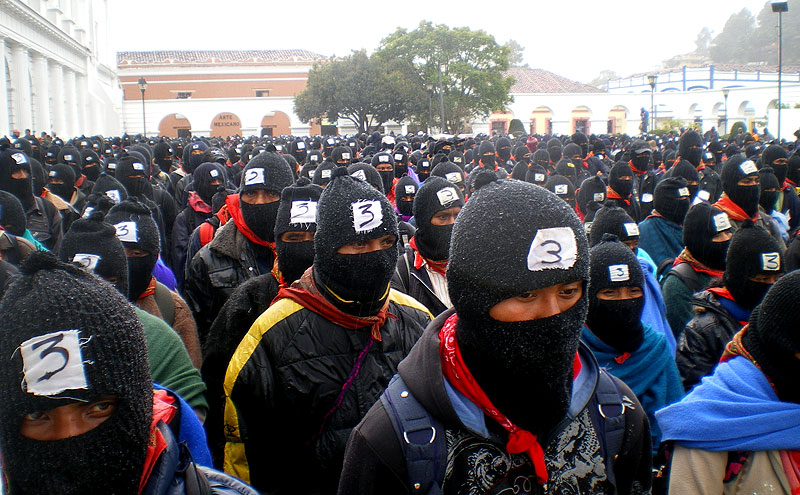
© SIPAZ
Conflictivity has worsened in various areas of the state, with several injured and murdered. In February, the Fray Bartolomé de Las Casas Center for Human Rights (CDHFBC) warned of the “imminent risk” that in the San Marcos Avilés ejido (Chilón municipality) “for the second time there could be a forced displacement of support-bases of the Zapatista Army of National Liberation (EZLN) committed by residents of the same ejido who were affiliates of different political parties.” In April, the Chiapas Peace Network carried out a Civil Observation Mission in this community, during which party members threatened to forcibly remove observers from their vehicles. In previous days, the Good Government Council (JBG) of Oventic also denounced the numerous aggressions suffered by Zapatista support bases in San Marcos Avilés since July 2011.
On 24 April, Juan Vázquez Gómez, former Secretary General of the adherents to the Other Campaign in the San Sebastián Bachajón ejido, was murdered by unidentified persons. The CDHFBC condemned the murder of Vázquez Gómez “who was known for his active defense of the land and territory in light of the government’s looting of the Agua Azul cascades.” It recalled that shortly before the attack, the ejidatarios of San Sebastian “publicly denounced that [their] territory is being threatened by the official policy of territorial looting, indicating continuity under the current state government.”
On 5 May in Venustiano Carranza, there were confrontations between members of the campesino organizations Casa del Pueblo Emiliano Zapata Campesino Organization (OCEZ-CP) and the Emiliano Zapata Campesino Organization-Chiapas (OCEZ-Chiapas), resulting in several injured and two dead. In September 2012, communards from the OCEZ-CP who are now affiliated with OCEZ-Chiapas occupied the offices of Casa del Pueblo, attacking members who had demanded clarification of the whereabouts of cattle that had been lost during the previous state government administration. In their respective communiqués, each group blamed the opposing organization for having initiated the conflict. OCEZ-CP demanded the expulsion of the dissident group and began the official process toward this end with the National Agrarian Registry, which has to date not resolved the case.
One person died and at least six others were injured in the Petalcingo ejido during a confrontation that also occurred on 5 May. The differences between the opposing groups intensified after the municipal elections of last July.
Social processes and the perception of closure of spaces
On 26 February, campesinos and indigenous persons belonging to 11 municipalities from the Sierra and Coast of Chiapas founded “civil guards for self-defense,” aimed at halting the looting of resources undertaken by mining firms in the state. These self-styled guards indicated that they saw themselves as obligated to choose this path, in light of the complicity of local and federal authorities with these firms.
In other news, between February and March, the Zapatista Army of National Liberation (EZLN) published a series of communiqués which formed a part of the series “Us and Them VII, The Smallest Ones.” Subsequently, Subcomandante Moisés announced the beginning of “little Zapatista schools” for August 2013, where autonomous rebel peoples will present their experiences in collective governance. He declared that until that time, the Zapatistas will not receive caravans or brigades, nor will they grant interviews.
In April, several media made public the intent of the state government to cancel the pilgrimage that was being organized by the Believing People in favor of the release of professor Alberto Patishtán, given that it coincided with the visit of Enrique Peña Nieto to Chiapas. The CDHFBC indicated that the government “demands a cancellation of the pilgrimage […] because it wants to present a scenario cleansed of social protest; this would be the first mass mobilization in the state capital during this new administration.” Nevertheless, the pilgrimage took place, with the participation of some 8,000 persons. It should be added that, once these public pressures were applied, governor Manuel Velasco Coello himself visited Patishtán in jail, committing himself to promoting his release as well as a new review of the cases of the other prisoners from the Voz del Amate organization, and those in solidarity with the Voz del Amate.
Another noteworthy event occurred that could perhaps be attributed to the previous administration, if not for the fact that the current Chiapas state government is operating with several of the same officials who worked in the previous administration. The lawyer Horacio Culebro Borrayas denounced that he had been victim of a death threat, after in April he demanded a trial against former governor Juan Sabines Guerrero and 50 members of his cabinet. Culebro Borrayas submitted to the Federal Attorney General’s Office (PGR) a complaint for at least twenty crimes, including criminal association, organized crime, and illicit enrichment.
On 11 April the daily copy of the Chiapas Herald newspaper was suspended and censored, after its front page that day ran the headline “Chiapas, on the edge of collapse because of Manuel Velasco’s lack of experience.” There were reports that in Tuxtla Gutiérrez people with police-style short hair surreptitiously followed the vendors and distributors of the daily so as to “buy the newspapers” or snatch them up. Two vendors affirmed that they were “held up with pistols by presumed police who took charge of confiscating the newspapers.” Also with regard to freedom of expression, in early April, the organization Article 19 published a communiqué regarding the reforms adopted on 7 March. These define as a crime in the Penal Code of Chiapas the obtaining of information from police and judicial sources, threatening to “criminalize access to information and freedom of expression,” thus making it even riskier for journalists to conduct investigations in the field and for citizens to exercise their rights to access to public information.
Impunity: the eternal task
16 persons charged for participating in the 1997 Acteal massacre have been recently released. This now comes to a total of 73 indigenous persons released who previously had been incarcerated for the massacre–not because they are innocent, but because there were violations of due process. Now just six people remain in prison for the crime. In an act that in fact was considered as a glimmer of hope in the face of impunity, a Mexico City judge has accepted a motion in favor of relatives of the victims of the massacre. With this, the petition for diplomatic immunity requested by the Mexican State in 2011 is nullified, thus increasing the chance that former president Ernesto Zedillo will in fact be prosecuted by a Connecticut state court for his presumed responsibility for this massacre. In the case of the freed prisoners, Noé Castañón, Secretary of Governance, has announced that, as was previously done with the others who have been released, there will be an agreement made to provide the newly released persons with lands so that they do not return to Chenalhó, so as to avoid problems in the area. Contradicting this planned course of action, the Las Abejas Civil Society has denounced that “[t]he paramilitaries who were released […] together with their relatives live peacefully, while they cause anxiety and fear in the communities.” They have reported gunfire in broad daylight in numerous communities.

